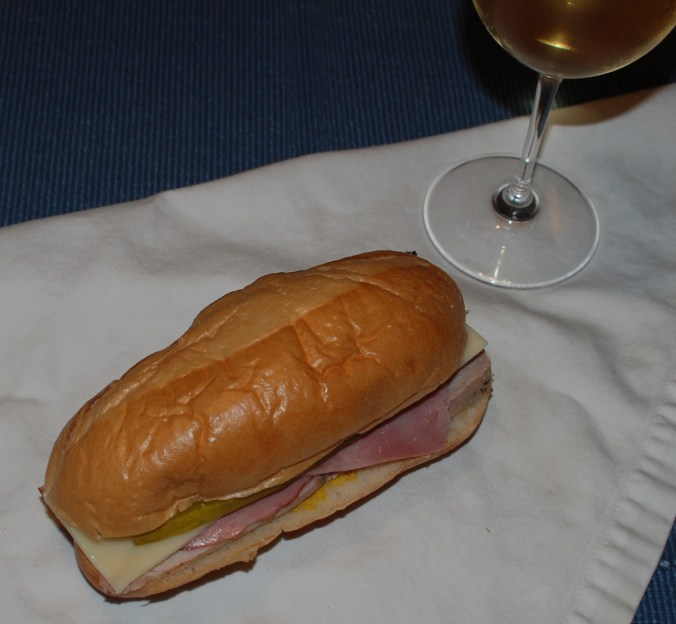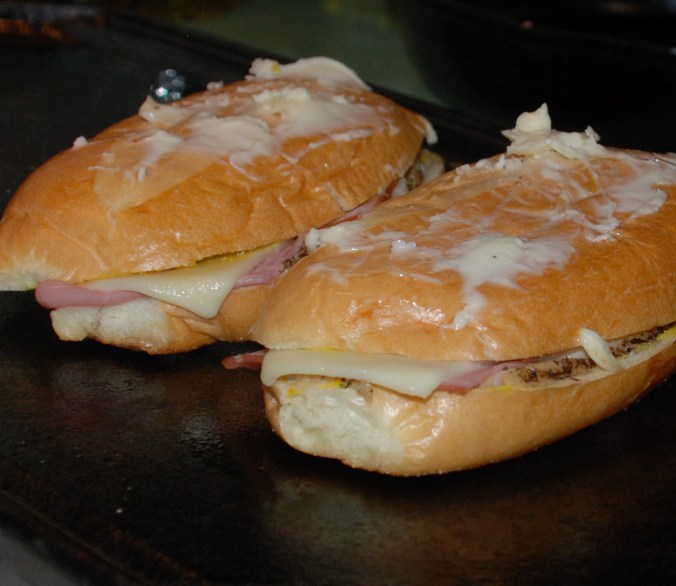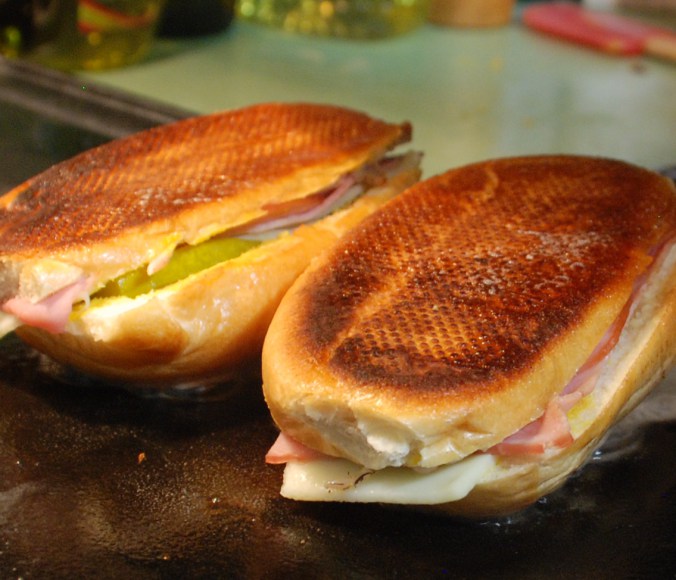There are people who go gaga for sandwiches. You don’t have to look very far to find folks who live for grilled cheese or who salivate over the Next Great Thing in burgers. Cheesesteaks, meatball parms, BLTs and PB&Js all cause hearts to race.
There are not many bad sandwiches but they exist. A cold Kraft Single on stale Wonder bread would be a bad sandwich. I have visited a bar in Barcelona several times where they make a sandwich of sardines and Roquefort cheese — sardinas con Roquefort is what they call it in Spanish. I have not eaten this sandwich and do not intend to when I return to La Champañeria but I like knowing that it exists.
I made a sandwich last night called a medianoche sandwich. I had seen an ad from Epicurious.com on my Twitter feed with a picture of a medianoche in it, and because the sandwich looked appealing I decided to make it. It is my excellent fortune to have a spouse who indulges my whimsy about cooking things of which I see pictures on Twitter ads. It is probably, however, just as well that one tends not to see ads on Twitter for sardinas con Roquefort. That could test the limits of spousal sandwich tolerance, especially when Epicurious uses such enticing pictures.

Depending on where you get your information about sandwiches, you might think the medianoche originated in Cuba. You might, on the other hand, believe that it was created in Florida by Cubans or simply to satisfy the taste of Cubans there. Regardless of who invented it and where, Saveur magazine says it is “the kind of sandwich you eat after hours of partying in Miami’s Cuban dance clubs.”
To the best of my recollection I have never partied in Miami Cuban dance clubs, much less for hours. For that matter, I have never partied in any Miami dance clubs. I stop short, however, of saying I have never partied in Miami at all because I have in fact attended a few establishments there in which alcohol was served for money, thus making them, I suppose, “clubs.” In any case my limited “partying” experience in Miami hardly equips me to describe the foods a more experienced Miami “partier” might care to eat late at night. What I know, I know largely from Epicurious.com and Saveur.
The medianoche sandwich is an assemblage of roast pork, ham, Swiss cheese, dill pickle and yellow mustard, pressed and toasted between buttered pieces of bread. Depending on your persuasion, that could mean utter blahsville or heaven.
The bread seems to be a key component of medianoche, possibly more than with other sandwiches. Ham is, after all, to a certain extent, ham. And roast pork, for all its charms, is roast pork.
Seriouseats.com says, “Medianoches are usually made with ‘pan suave,’ a soft, sweet bread. Since it is not widely available, I’ve substituted it with 6 inch-long challah rolls, which are sweet and soft like the original.”
The Epicurious recipe that initially drew my attention calls for “4 large rolls (of) Pan de Media Noche or sweet roll-like brioche or challah.” Another recipe’s ingredients list shows simply, “4 medianoche bread.” Somebody else recommends, “eggy bread such as challah or brioche.”
With no offense intended to Epicurious or Seriouseats or anybody else, that’s a good one.
In the part of the country where I live, I am more likely to see Scottish grouse, ostrich eggs or whole Alba truffles on a supermarket shelf than challah or brioche.
It is well within my range of skills to bake a loaf of eggy bread but it would be a lot of work for two sandwiches. Then again, I have quite a few times made W. Park Kerr’s Cornmeal Kaisers from his most excellent Burning Desires cookbook, just to use for the swordfish club sandwiches in the same book.
For the medianoche project we found soft bolillo rolls. I am hardly an authority on Mexican cuisine but I suspect these bolillos were not the best bolillos. Their interior was soft, as it’s supposed to be, but their exterior was also soft. The exterior of a bolillo is not supposed to be soft. But one makes do.
For the roast pork I made…roast pork. Onto a small boneless loin roast I rubbed salt, pepper and dried thyme, and then slid it into a hot oven for a while.
The ham is uncured ham we bought at an upscale supermarket in Mandeville, La. I do not care to name the market because I feel somewhat dirty about shopping there. I conducted a personal boycott of this nominally proletarian supermarket chain for quite a few years after their CEO made some very Wall Street-y comments in the Wall Street Journal about universal healthcare. It was only after moving to the relative culinary desolation of the rural Deep South that I bent. I am not proud of my behavior but the draw of French cheese, seafood-other-than-catfish, leeks and veal was just too strong.
Dressing for medianoche is pretty straightforward: yellow mustard and dill pickle.
I wasn’t inclined to spend a lot of money on cheese for my medianoche. We used grocery store Swiss slices. Maybe one day I will make medianoche using aged Gruyère and see if it makes much difference.
It is simple to assemble a medianoche.
We made four medianoches — two for dinner and two for lunch mañana.
Onto the griddle the first two sandwiches went.
Recall, please, that the medianoche is a grilled and pressed sandwich. Pressing can come by means of a sandwich press machine, which you can buy at Sur La Table or Williams-Sonoma. Pressing can also occur beneath the weight of a cast iron skillet. That is how my medianoches were pressed.
Butter on the outside of the sandwich helps with crispness. Also butteriness.
Turn your medianoche.
Replace your press.
For all the effort that had gone into it, my medianoche was a good sandwich but not a great one. But for all my effort, I am not inclined to return to the process just now and fuddle over the role the bread or the ham or the cheese or even my own participation played.
Perhaps my heart was not in the medianoche. Maybe this weekend I will make some Cornmeal Kaisers and prepare Swordfish BLTs from the recipe in Burning Desires.














